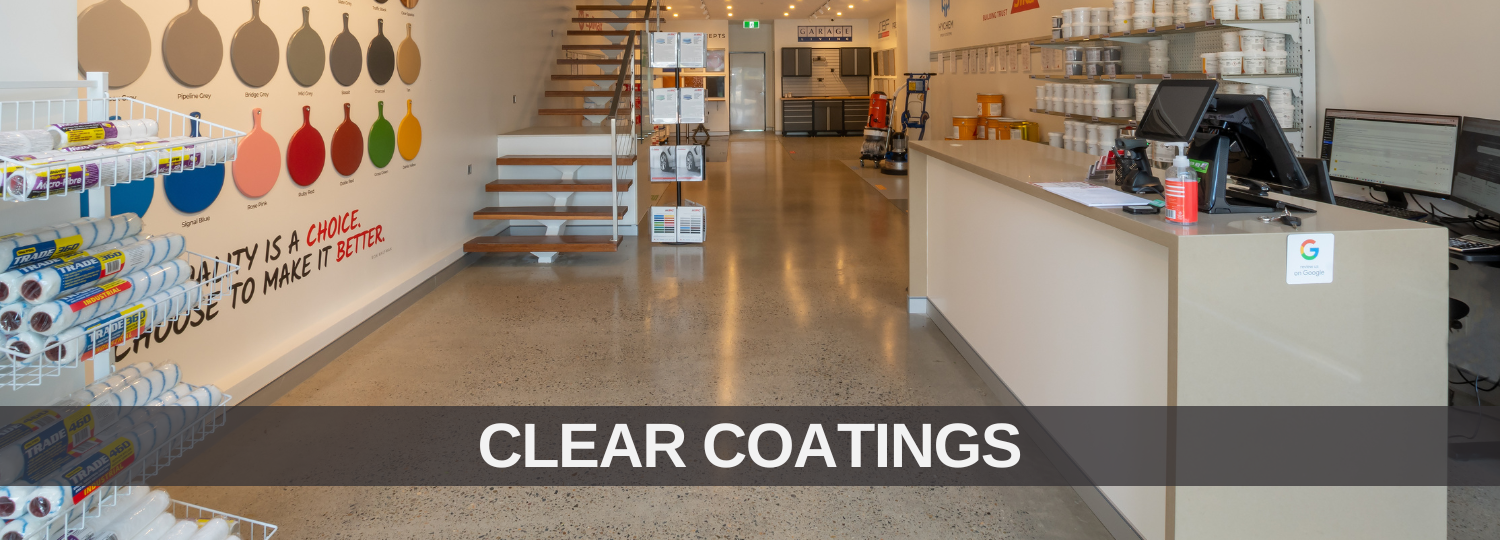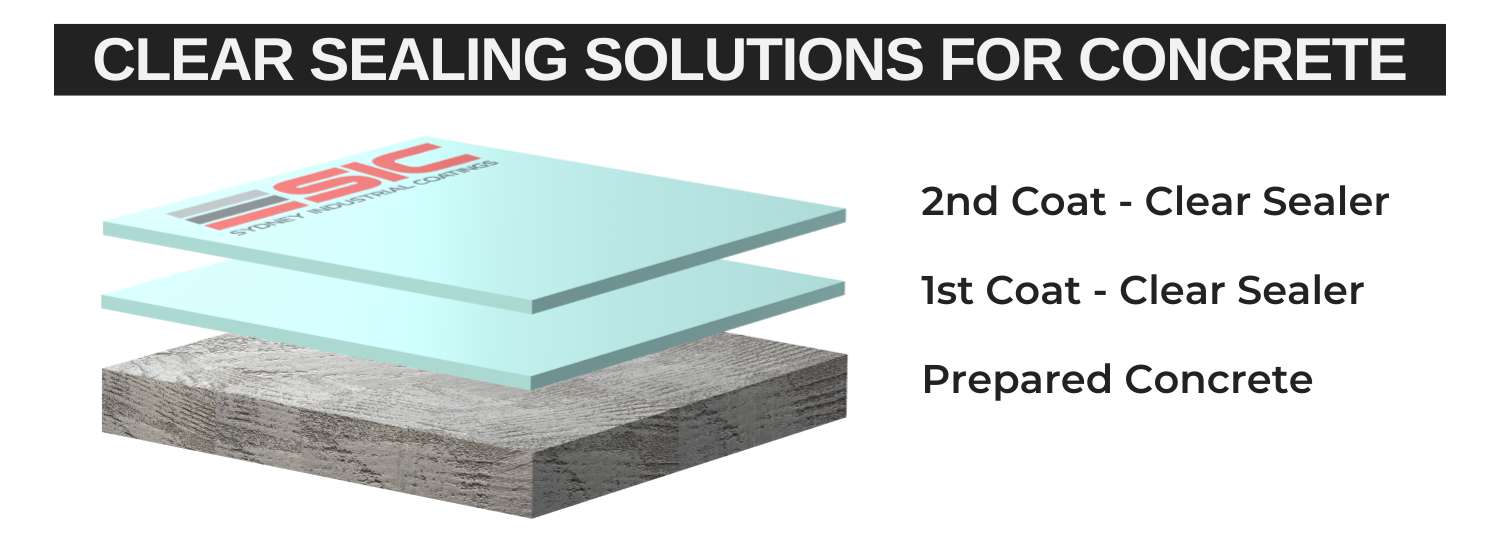Australia Wide Shipping
Australia Wide Shipping

Clear concrete sealers and polyurethane finishes are products that can be used to protect and enhance the appearance of the concrete surface inside showrooms and other retail or commercial environments. They are applied as a clear liquid and are designed to seal and protect the concrete from moisture, stains, and other types of damage. Clear floor coatings are an ideal solution for retail spaces that want their natural salt and pepper concrete-look with the added protection and benefits of a high quality concrete sealer. There are many different types of clear concrete sealers available for commercial industries including penetrating sealers, topical sealers, polyurethanes and more.
Penetrating sealers
Penetrating sealers for concrete floors are a type of concrete sealer that penetrates deep into the concrete substrate to protect it from water, stains, and other contaminants. Unlike topical sealers that create a film on the surface of the concrete, penetrating sealers work by filling the microscopic pores and capillaries of the concrete with a hydrophobic barrier. This barrier repels water and other liquids, preventing them from penetrating the concrete and causing damage.
Clear penetrating sealers are typically made from a variety of materials, such as silicates, silanes, and siloxanes, and may come in different formulations depending on the specific needs of the project. For example, some penetrating sealers are designed to be used on new concrete, while others are formulated for use on older, more porous concrete. Additionally, some penetrating sealers are designed to be used on exterior concrete, while others are better suited for interior applications.
One of the primary benefits of penetrating sealers is that they do not change the appearance or texture of the concrete, unlike topical sealers that can leave a glossy or matte finish. This can be particularly beneficial for decorative concrete surfaces, such as stamped or stained concrete, where the texture and color of the concrete are important design elements.
Overall, penetrating sealers are an effective way to protect concrete floors from damage, while maintaining their natural appearance and texture.
Topical Sealers
Topical sealers for concrete floors are a type of sealer that forms a protective film or layer on the surface of the concrete and can provide a glossy or matte finish depending on the specific type of sealer used.
Clear opical sealers are applied directly onto the surface of the concrete, and can provide a range of benefits depending on the specific formulation of the sealer. Some topical sealers are designed to protect concrete from water, stains, and other contaminants, while others are formulated to enhance the color and appearance of the concrete.
There are different types of topical sealers available, including acrylic, epoxy, and polyurethane sealers. Acrylic sealers are typically the most common type of topical sealer, and are often used on decorative concrete surfaces such as stamped or stained concrete. Epoxy and polyurethane sealers are more durable and provide better protection against abrasion and chemicals, but are typically more expensive.
One of the main benefits of topical sealers is that they can enhance the appearance of the concrete, making it look more vibrant and colorful. They can also provide a layer of protection against scratches, stains, and UV damage, which can extend the life of the concrete.
Polyurethanes
Clear polyurethane coatings are an excellent choice for concrete floors in showrooms and shops. They are often used on high-traffic concrete floors, such as those found in retail, industrial or other commercial settings, because they provide excellent protection against abrasions, staining, discolouration, and UV damage.
One of the primary benefits of clear polyurethane coatings is that they can provide a glossy or matte finish, depending on the specific formulation used. This can be beneficial for enhancing the appearance of the concrete and creating a more polished, professional look.

Showing all 4 results
To achieve a successful floor coating system make sure your surface is free of dust, oil/grease, any loose particles or paint and moisture. Click on the options below for further information
Epoxy Flooring Tools Information
Epoxy Floor Coating Preparation
Floor Grinders: Floorex 480mm Grinder | Husqvarna 450mm Grinder | Scintex 250mm Grinder
Vacuums & Dust Extractors: Floorex | Husqvarna S36 (3 motor phase) | Husvarna S13 (single phase)
Diamond Grinding Plugs: Rectangle | Arrow | PCD (to remove previously coated or adhesives on the floor)
Redi-Lock Diamond Plugs: Sydney Industrial Coatings (9 pack)
Diamond Grinding Cup Wheels: 125mm to 250mm
Ensure the floor is level and polished consistently to avoid grinding marks or imperfections showing in the completed application.
Diamond Grinding Cup Wheels: 125mm to 250mm
As this is a clear floor coating system, patching imperfections will be very noticable on the floor. It is completely up to the applicator’s preference as most prefer the natural look of the cracks and feel that the imperfections are what make the floor perfect for them.
Fill in all your cracks using a 2-pack epoxy filler and wait until the patching mortar is fully cured before grinding or coating the floor, this process usually takes a minimum of 6 – 8 hours.
For larger cracks and spalls: SIC Epoxy Coving & Repair Kit | Sika Sikadur 31 CFN
For smaller patching and cracks: Sika Sikadur 33 | Sikadur 513 (magic powder mixed into epoxy to thicken up)
General curing time (at 20°C) is a minimum of 8 hours. This can vary further if solvent has been added to the coating. General curing time (at 20°C) is minimum 8 hours. It is always reccomended to back roll the product against the natural light to assist with achieving a more uniform finish. Wearing spike shoes to walk over the epoxy can help ensure the product is applied evenly, however you must apply safety practices and be cautious of injury.
Aliphatic Polyurethanes: UltraKote UVSeal (Gloss only)
Waterbased Polyurethanes: UltraKote SuperClear (available in Gloss or Matt)
Waterbased Epoxies: EpiMax 999WB (comes in Satin or Matt)
Concrete Sealers: Sikafloor Duraseal
If this step if not completed within 30 – 36 hours (depending on temperature) of applying the previous coat, the floor will need to be scratched using an 80 grit sand paper.
If you are applying the system over porous concrete, a third coat may be required. If a third clear coating is required, repeat above.
Antislip media can be added to the topcoat to achieve a higher slip rating
Your floor will be trafficable after 24 hours and heavy items such as cars, boats or trailers shouldn’t be parked on the floor for 7 days after application of the final coat